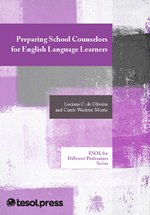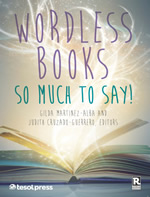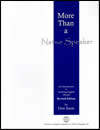Quick Tip: 7 Ways to Get ELLs Talking
by Alma L. Contreras-Vanegas and Burcu Ates
Audience: ELLs of all proficiency levels and grades
ELLs are often reluctant to speak English in the classroom because they are not confident in their oral language and fear ridicule by peers. Teachers can create a safe environment where ELLs are willing to take risks and speak in the classroom by lowering the affective filter, which can be achieved by utilizing games and fun group activities. The following activities have been used by the authors with ELLs at various proficiency levels.
1. Telephone
Students form lines of numbers. Leaders of each line are given a word, phrase, or sentence (depending on English proficiency) to whisper to the next student, and so on down the line. The last person in line announces what he or she heard. This usually results in laughter because the message is rarely the original one. For more advanced students, try using tongue twisters or silly sentences for even more humor.
2. Mix Pair Share
The teacher plays music in the background while students silently walk around the room. Once the music stops, students find a partner nearby and share information on a topic. This information can be answers to questions from a story, math problems, or the weekend’s activities. Teachers repeat the process as many times as desired.
3. Information Gap
In this activity, students play detective and work with others to find the missing clues. Student A will have information that student B does not have, and vice versa. Students need to communicate with each other by asking questions to complete the missing parts. The information can be from academic content from any subject, story plots, magazine articles, or even just simple sentences.
4. “Who Am I?”
The teacher writes vocabulary for living and nonliving objects using index cards. Words may include “television,” “flower,” cartoon characters, and so on. The teacher tapes an index card on each student’s back, and students need to figure out “who” or “what” they are by asking questions such as, “Am I living?” or “Am I a food?” Only yes/no questions are permitted, and students cannot ask the same person a second question until they’ve asked every other student in class a question.
5. Scavenger Hunt
The teacher prepares a list of items students need to find. The list can be based on letters of the alphabet or a content-area topic. ELLs work together to hunt for the items on the list while discussing the items they need to find. Depending on the students’ English proficiency level, teachers may provide sentence stems for ELLs to begin sharing with classmates of what they found.
6. Reader’s Theater
ELLs of all levels can participate in Reader’s Theater. Beginning ELLs should be given short, repetitive phrases in a script while more advanced ELLs can read complex lines. ¡Colorín Colorado!, Drama in the ESL Classroom, and Readers Theater: A Superfood for Oral Skills are great resources to further assist with Reader’s Theater specifically for ELLs.
7. Gallery Walk
One way to do a gallery walk is to have several pieces of chart paper with various headings placed around the room. For example, the headings can be title of books students will be reading during the semester. In pairs or small groups, students share predictions based on the titles of the books. Once all pairs or groups have had a chance to share and write their predictions with each other, they discuss their predictions with the whole class.
Alma L. Contreras-Vanegas, PhD, is an assistant professor at Sam Houston State University teaching in the department of Language, Literacy, and Special Populations. Her research interests include bilingual/dual language education and ELL writing development.
Burcu Ates, PhD, is an assistant professor of ESL/Bilingual Education at Sam Houston State University. Her research interests include pre- and in-service teacher preparation and ESL/EFL methodologies and strategies.
TC Monthly Giveaway Congratulations to Liliia Kurushyna, of Odessa, Ukraine, for being the winner of the December 2015 TESOL Connections Monthly Giveaway. Liliia has won a free registration to the 2015 TESOL Annual Convention & English Language Expo in Baltimore, MD, USA.
This month, TESOL is giving away
A free membership renewal!

Renew your membership for free, and resolve to advance your development as an educator in 2016.
Click here to enter
Drawing closes 25 January 2016, 11:59 pm EST
TESOL Blogs Interested in writing a blog for TESOL?
Read the submission guidelines and send us your post!
Check out the latest TESOL Blogs:
|
The Changing Role of the ESL Teacher, by Judie Haynes
 This week’s primary education blog is guest authored by Shaeley Santiago, an ESL teacher and instructional coach from Iowa. Shaeley and I first met 4 years ago on #ELLCHAT, a Twitter chat that I comoderate. We have since met up at TESOL and other conferences. I’m sure you’ll learn a lot from her: This week’s primary education blog is guest authored by Shaeley Santiago, an ESL teacher and instructional coach from Iowa. Shaeley and I first met 4 years ago on #ELLCHAT, a Twitter chat that I comoderate. We have since met up at TESOL and other conferences. I’m sure you’ll learn a lot from her:
When I first began teaching at a middle school in a small Iowa town just before No Child Left Behind (NCLB) was passed, ESL was about helping students learn survival English and American culture. Today, however, increased accountability for subgroups like ELLs and a greater focus on college- and career-ready standards for all students have caused educators to recognize the necessity of instructing ELLs simultaneously in language and content (see Hakuta’s “Freedom to Talk” video). Read More. |
|
Teaching Cohesion, by Robert Sheppard
 We all want our students to produce coherent, cohesive writing. Since I first started teaching, I’ve asked my students to produce “coherent, cohesive writing.” Thing was, back then I could have clearly defined neither coherent nor cohesive, nor could I have effectively distinguished between the two concepts. But when we’re teaching—especially writing, but the other skills as well—it can be valuable to introduce these ideas to students, cohesion in particular. We all want our students to produce coherent, cohesive writing. Since I first started teaching, I’ve asked my students to produce “coherent, cohesive writing.” Thing was, back then I could have clearly defined neither coherent nor cohesive, nor could I have effectively distinguished between the two concepts. But when we’re teaching—especially writing, but the other skills as well—it can be valuable to introduce these ideas to students, cohesion in particular.
In this post, I’ll define and differentiate these terms, and provide some quick tips for incorporating cohesion into your teaching. Read More. |
|
It’s a Piece of Cake: Easy Ways to Teach Tricky Idioms, by Nathan Hall
 If I described your writing assignment as “horse horse tiger tiger,” what am I saying about it? Would you “try to cut the pear in two” to figure out what my feedback meant? Or would you assume I “don’t have all my cups in the cupboard”? I can do this “from sun to sun.” If I described your writing assignment as “horse horse tiger tiger,” what am I saying about it? Would you “try to cut the pear in two” to figure out what my feedback meant? Or would you assume I “don’t have all my cups in the cupboard”? I can do this “from sun to sun.”
With that, I’d like to “put in my two cents” and say that idioms are one of the trickiest parts of a language. We native speaker use them “off the cuff,” but unless you’re familiar with Chinese, French, German, and Spanish most of the previous paragraph “is all Greek” to you. Read More. |
|
7 Principles of Written Feedback, by Elena Shvidko
 A few weeks ago, the TESOL Second Language Writing Interest Section had a webinar on written feedback, monitored by Dana Ferris—the author of multiple books and articles on response to student writing. I found the webinar extremely helpful, and I would like to share some principles of feedback mentioned during the discussion. Read More. A few weeks ago, the TESOL Second Language Writing Interest Section had a webinar on written feedback, monitored by Dana Ferris—the author of multiple books and articles on response to student writing. I found the webinar extremely helpful, and I would like to share some principles of feedback mentioned during the discussion. Read More.
|
TESOL Bookstore

Featured Resources from TESOL Press
 Preparing School Counselors for English Language Learners Preparing School Counselors for English Language Learners
Luciana C. deOliveira and Carrie A. Wachter Morris
This title focuses on the specific knowledge and skills that school counselors need to develop in order to best serve ELLs in their schools. These skills include knowledge of current roles and responsibilities of school counselors; legislation such as Title III of NCLB, and the Bilingual Education Act; and an overview of issues such as second language development and multicultural counseling practices, and appropriate counseling interventions.
 Wordless Books: So Much to Say! Wordless Books: So Much to Say!
Gilda Martinez-Alba and Judith Cruzado-Guerrero, Editors
Enable your students to be successful regardless of their literacy levels. Wordless books help to develop oral language, listening, vocabulary, and so much more! With wordless books, K–12 and adult students can be authors and write stories that they interpret from the pictures. Includes additional online resources and editable rubrics.
 More Than a Native Speaker, Revised More Than a Native Speaker, Revised
Don Snow
This TESOL Press best-seller provides a nontechnical introduction to English teaching for native-English-speaking teachers working outside their home countries. The revised edition includes an expanded discussion of student-directed language learning, workbook activities for volunteer teachers enrolled in courses or studying the book individually, and a full array of culture-based discussion topics for use as supplementary activities or core material for an English course.
|
 |
|
|
 |
| EFL Instructor, St. Mary College - Nunoike Gaigo Senmon Gakko/Culture Center, Nagoya, Japan
Senior Lecturer, ESOL (Nontenure Track), Syracuse University, Syracuse, New York, USA
Advanced Assistant or Associate Professor (Tenure Line), University of Maryland, Baltimore County (UMBC), Baltimore, Maryland, USA
Want to post your open positions to Job Link? Click here.
To browse all of TESOL's job postings, check out the TESOL Career Center. |
 |
|
 |
| ADVERTISEMENT |
 |
 |
|